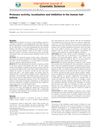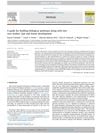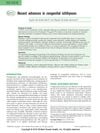Transgenic Kallikrein 14 Mice Display Major Hair Shaft Defects Associated with Desmoglein 3 and 4 Degradation, Abnormal Epidermal Differentiation, and IL-36 Signature
TLDR Mice with extra human KLK14 had hair and skin problems, including weaker cell bonds and inflammation, linked to Netherton syndrome.
The study investigated the effects of overexpressing human kallikrein 14 (KLK14) in transgenic mice (TghKLK14) and found significant hair shaft defects and abnormal epidermal differentiation. These defects were linked to the degradation of desmoglein 3 and 4, essential for cell adhesion in the epidermis. Additionally, the mice exhibited increased expression of inflammatory markers such as IL-36A and IL-17C, indicating an inflammatory response. The findings suggested that KLK14 played a critical role in hair and skin pathology, offering potential insights into conditions like Netherton Syndrome. The study included multiple experiments with at least four mice per genotype, ensuring robust data.



